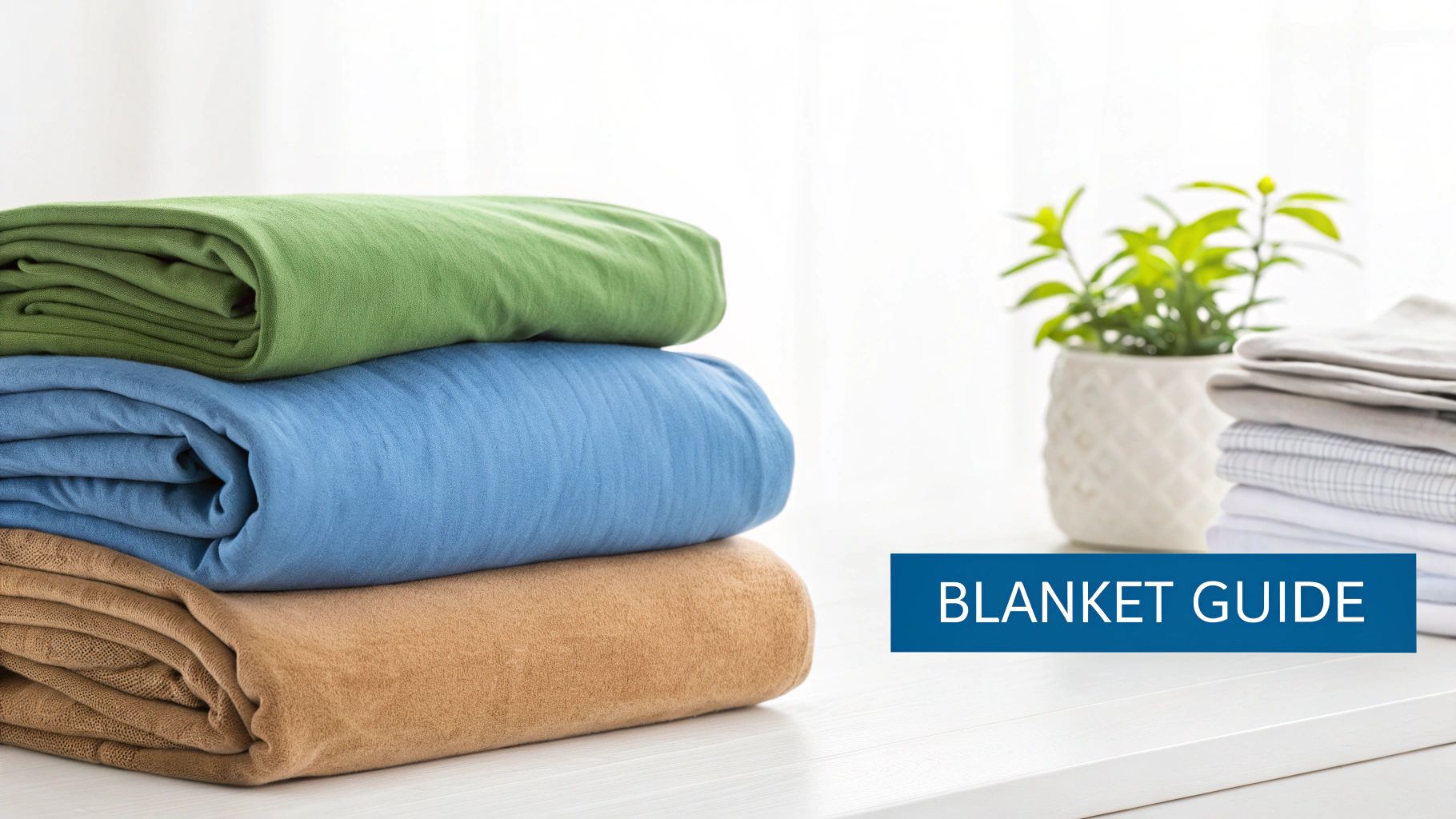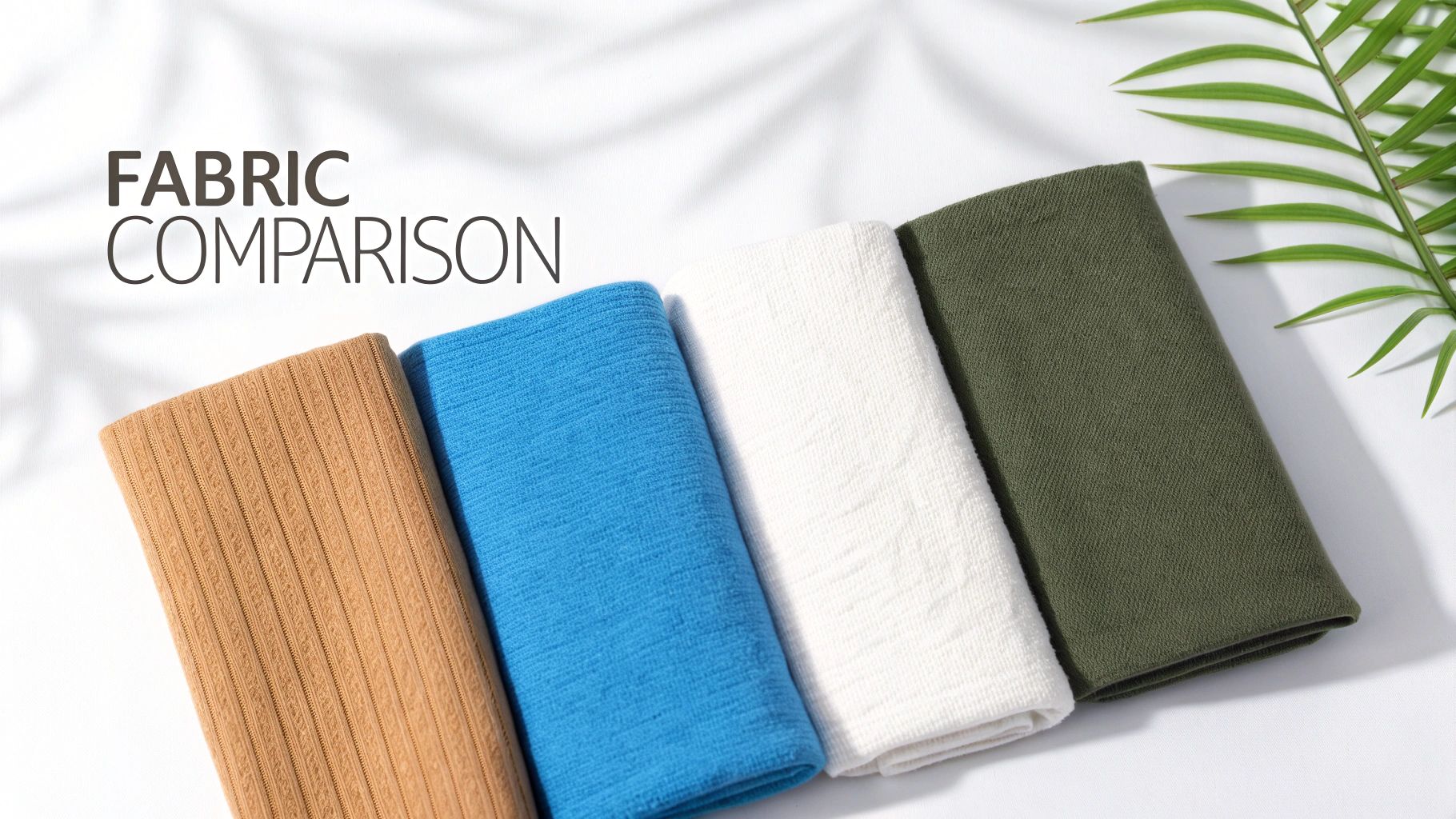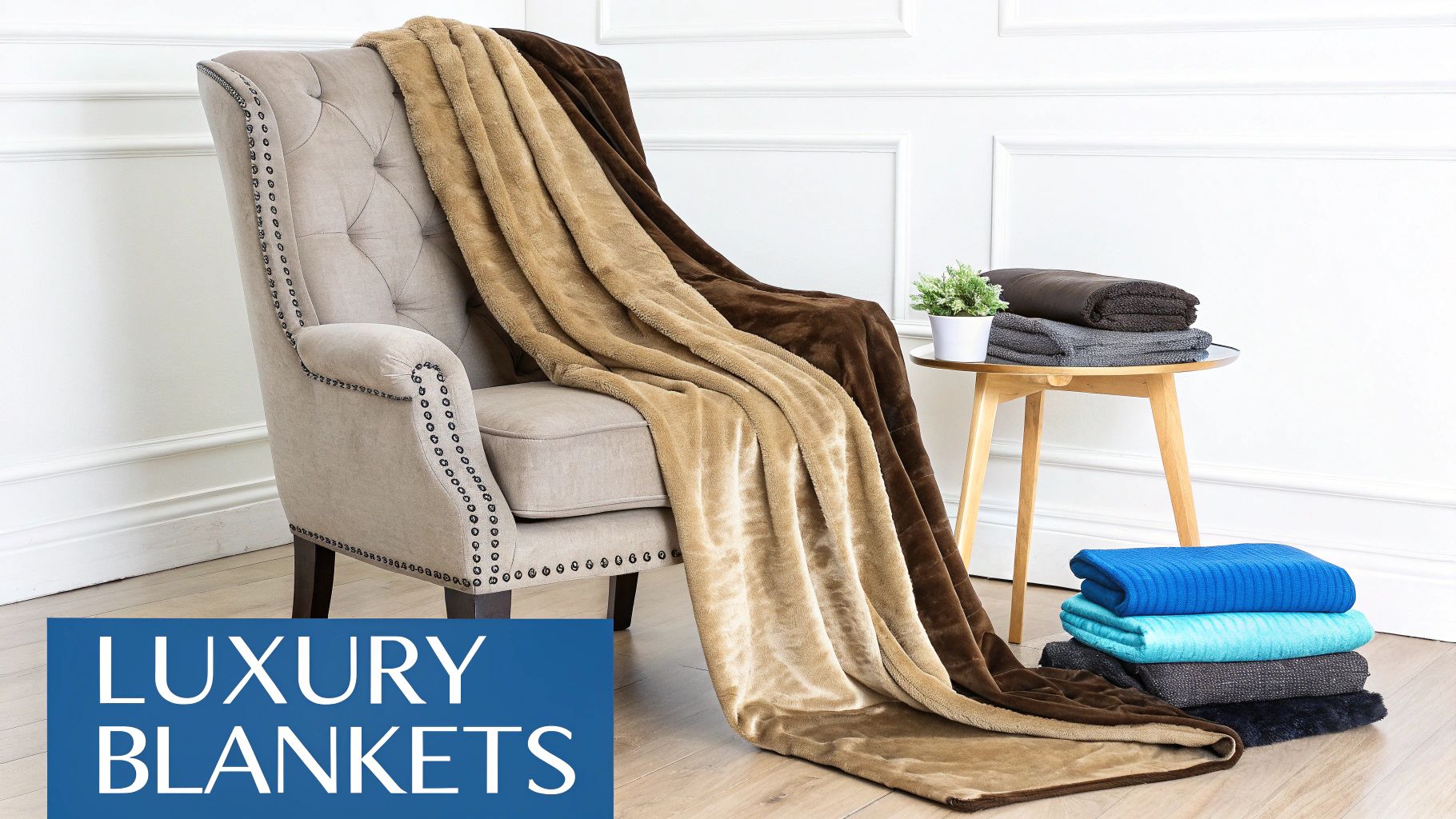Trying to pick the best blanket material can feel overwhelming, but it really just boils down to what you need. Think of it like picking a jacket—what works for a cool autumn evening won't cut it in a blizzard. For an all-around great choice, cotton is a classic for a reason. It's breathable, soft, and just works. But if you're always cold, nothing beats the serious warmth of wool. And for those who sleep hot, lightweight options like bamboo or linen are game-changers.
Your Ultimate Guide to Choosing Blanket Materials
So, what makes a blanket feel perfect? It's all about you—whether you run hot at night, need something tough enough to handle kids and pets, or have allergies that make you picky about fabrics. This guide is here to cut through the noise and help you find your perfect blanket.
We'll start with a quick overview of the main players, from natural fibers like cotton and wool to modern synthetics like fleece. The goal is simple: give you the confidence to choose a blanket that doesn't just look good, but actually improves your sleep.

Key Material Differences at a Glance
Every fabric has its own unique personality, offering a different mix of warmth, breathability, and feel. Getting a handle on these core differences is the first step to finding your match. Think of this as your cheat sheet.
| Material | Primary Benefit | Ideal For | Warmth Level |
|---|---|---|---|
| Cotton | Breathability & Softness | Year-round use, allergy sufferers | Moderate |
| Wool | Superior Insulation | Cold sleepers, winter nights | High |
| Fleece | Lightweight Warmth & Affordability | Kids, casual throws, budget-conscious | Moderate |
| Bamboo | Cooling & Moisture-Wicking | Hot sleepers, humid climates | Low |
| Linen | Exceptional Breathability & Durability | Warm weather, hot sleepers | Low |
This table gives you the headlines, but the real magic is in the details. Let's dive deeper into what makes each of these materials special.
A Quick Comparison of Popular Blanket Fabrics
Picking the right blanket can feel overwhelming with all the options out there. Before we get into the nitty-gritty of each material, let’s start with a bird's-eye view. This is your cheat sheet for quickly figuring out which fabrics might be a good fit for you.
Think of it as a starting point. Are you always cold? Or do you kick the covers off halfway through the night? The table below will help you zero in on the materials that best match your needs, whether that’s all-out warmth, airy breathability, or something in between.

This quick scan should help you narrow the field before we dive deeper into what makes each fabric unique.
Blanket Material Quick Comparison Guide
Each material brings something different to the table. Some, like wool, are champions of insulation, while others, like linen, are all about airflow. Here's how they stack up at a glance.
| Material | Primary Benefit | Best For | Warmth Level | Breathability |
|---|---|---|---|---|
| Cotton | Versatility & Softness | Year-round comfort, layering | Moderate | High |
| Wool | Superior Insulation | Cold sleepers, winter climates | Very High | High |
| Fleece | Lightweight Warmth | Cozy throws, kids' rooms | Moderate | Low |
| Bamboo | Cooling & Hypoallergenic | Hot sleepers, sensitive skin | Low | Very High |
| Linen | Exceptional Airflow & Durability | Summer nights, warm climates | Very Low | Exceptional |
As you can see, the trade-offs are pretty clear. If you’re constantly cold, wool is a fantastic natural insulator. For those trying to decide between natural fillings, getting into the weeds with a wool vs down quilt comparison can offer even more clarity.
But if you run hot, that same wool blanket would feel like a furnace.
Key Takeaway: The "best" material is completely subjective. It all depends on your body, your climate, and what you find comfortable. A wool blanket is a dream for one person and a nightmare for another who needs the cooling power of bamboo or linen.
Think of this chart as your map. Now, let’s get into the details and explore the specific feel, performance, and quirks of each of these popular blanket materials. This will help you go from a rough idea to a choice you’ll be happy with for years to come.
Analyzing The Feel And Function Of Each Material
Choosing a blanket isn’t just about picking a color. It’s about how it drapes over you, how it traps—or releases—heat, and how it feels every time you pull it up to your chin.
In the sections that follow, we’ll zero in on six popular fabrics. You’ll see why wool hugs you with a reassuring heft, why linen whispers cool breezes, and why bamboo feels like silk on your skin. By the end, you’ll have a clear picture of which blanket belongs on your bed.
Cotton: The All-Rounder
Cotton earns its reputation by simply doing it all. Its natural fibers are soft, subtly textured, and endlessly breathable.
- Texture: Ranges from crisp and smooth (percale) to plush and fuzzy (flannel).
- Insulation: Offers moderate warmth that adapts as room temperatures shift.
- Moisture Management: Highly absorbent, pulling sweat away—but can feel damp in very humid conditions.
Imagine a classic woven cotton throw. It has enough weight to feel secure, yet the open weave welcomes airflow. For many, it’s the perfect year-round companion—light enough in summer, layering-friendly when the chill sets in.
Wool: The Natural Insulator
Wool stands apart because of its crimped fibers, which trap thousands of tiny air pockets. Those pockets become miniature heat-traps, locking in your body warmth when you need it most.
At the same time, wool can hold up to 30% of its weight in moisture without feeling soggy, wicking sweat away so you stay dry and cozy.
“Thinking all wool is scratchy and heavy? Modern merino throws prove that you can have soft, fine fibers without any bulk.”
- Breathability: Remarkable airflow despite serious insulation.
- Temperature Regulation: Keeps you warm on cold nights and surprisingly comfortable as things warm up.
- Durability: Resists pilling and can last for decades if cared for properly.
Fleece And Microfiber: The Synthetic Comfort Kings
Remember the instant cocoon of a fleece blanket? That plush, velvety pile is engineered from polyester to give you lightweight warmth at an unbeatable price.
- Softness: Ultra-plush nap that feels cozy the moment you touch it.
- Weight: Featherlight, yet surprisingly toasty.
- Maintenance: Machine-washable, wrinkle-resistant, and built to withstand everyday use.
In fact, polyester blankets claimed about 39.5% of the market revenue in 2024, proving that comfort and convenience remain top priorities.
- Trade-Off: Incredible heat retention comes at the cost of low breathability—hot sleepers, beware of overheating and that “stuffy” feeling.
Bamboo And Viscose: The Silky Smooth Coolers
If nights often turn muggy or you’re chasing that just-right temperature, bamboo-derived fabrics feel like a revelation. Their fibers are naturally porous and super-fine, delivering an almost liquid drape across your skin.
- Moisture-Wicking: Quickly pulls sweat away so it can evaporate instead of pooling.
- Silky Handfeel: Smoother and more fluid than cotton—think gentle hugs instead of firm support.
- Weight: Extremely lightweight, giving you the sensation of sleeping on air.
Comparing Bamboo to Cotton:
- Feel: Bamboo glides; cotton feels more structured.
- Cooling Power: Bamboo wins for active cooling.
- Drape: Bamboo falls softly, whereas cotton holds its shape more.
For anyone who wakes up hot and clammy, bamboo blankets stand out as the go-to choice.
Linen: The Crisp And Airy Classic
Linen, spun from flax, has been around for millennia—and with good reason. It starts out with a slightly rustic texture that only improves wash after wash, gaining character and softness.
- Airflow: The hollow core of flax fibers lets air flow freely, making linen one of the most breathable fabrics.
- Temperature Regulation: Surprises by cooling in summer and staying comfortably cozy as evenings cool down.
- Antimicrobial & Moisture-Wicking: Naturally resists bacteria and pulls humidity away from your skin.
- Longevity: Grows softer over time and, with proper care, becomes an heirloom rather than a throwaway.
If you want a blanket that feels fresher with every wash and adapts gracefully to your environment, linen is hard to beat.
Matching Blanket Materials to Your Lifestyle
Choosing the right blanket isn't about finding one "perfect" fabric. It’s about matching a material’s unique personality to your own. The blanket you'd grab for a freezing winter night is the total opposite of what you’d want on a sticky summer evening. When you zero in on what you actually need, you can find a material that genuinely improves your comfort and sleep.
So, let's break down the best options for a few common situations. This isn't just about listing fabrics; it's about connecting the science of the material to your real-world comfort. Think of it as finding a personalized sleep solution, not just another blanket.
For Hot Sleepers and Warm Climates
If you're constantly fighting with your covers or live somewhere the air feels thick and humid at night, breathability is everything. You need a blanket that lets heat and moisture escape so you don't wake up feeling stuffy and damp.
- Linen: This is the undisputed champ for airflow. Linen’s hollow fibers create a super-breathable weave that feels crisp and cool on your skin while actively pulling moisture away from your body.
- Bamboo/Viscose: Known for that silky, cool-to-the-touch feeling. This material is a pro at wicking away moisture and drapes over you lightly without trapping any heat.
- Lightweight Cotton: A good percale or gauze weave offers fantastic breathability with a classic soft touch, making it a reliable and versatile pick.
All these materials excel by promoting evaporation, which is the key to staying cool. Getting this right is a huge part of creating the ideal sleep environment. If you want to dive deeper, we have a detailed guide on the best temperature for sleep.
For Homes with Kids or Pets
In a busy household, durability and easy cleaning are non-negotiable. You need a blanket that can survive spills, constant washing, and general chaos without falling apart or losing its softness. The best blanket material for this kind of life has to be both tough and cozy.
Your best friends here are sturdy natural fibers and modern synthetics.
- Fleece/Microfiber: These polyester-based fabrics are practically built for family life. They resist stains, are a breeze to machine wash, and are incredibly durable. Plus, they don't really shrink or wrinkle, making them perfect for movie night forts or a kid's bed.
- Cotton: A strong cotton blanket, particularly with a tight weave like a matelassé, can handle countless trips through the laundry. There's a reason cotton is so popular worldwide—it’s reliable and comfortable. Market trends even show cotton blankets have a huge share of the global market, valued for being hypoallergenic and easy to clean. You can read more about what consumers are buying on Future Data Stats.
This decision tree gives a good visual for whether you should be looking for instantly warm fabrics or ones that feel naturally cool.

As the chart shows, if you're after that instant cozy feeling, materials like fleece and wool are your go-to. But if a cooler sleep is what you crave, you’ll want to lean toward linen or bamboo.
For Allergy Sufferers
When you're prone to allergies, the fabric you sleep under can make a world of difference. The mission is to find a material that naturally fights off common irritants like dust mites, mold, and pet dander.
Hypoallergenic materials create an environment where allergens just can't thrive. They're often tightly woven to keep dust mites out and have natural antimicrobial properties.
Here are the top contenders:
- Wool: It’s naturally antimicrobial and a poor host for dust mites.
- Bamboo: Its moisture-wicking powers are fantastic for preventing the growth of mold and mildew.
- Cotton: You can easily wash it in hot water, which is one of the most effective ways to kill dust mites and wash away allergens.
Exploring Specialty And Luxury Blanket Options

Some fabrics go beyond basic warmth and turn your blanket into a calming tool or a sensory indulgence. These specialty options aren’t just throws—they’re investments in a different level of comfort. They answer specific needs, whether it’s easing anxiety or delivering a sumptuous touch.
Take weighted blankets, for example. The secret is in their layered design. The shell often uses plush minky microfiber for a super-soft hand feel, while the interior holds thousands of tiny glass beads or plastic pellets.
- Outer Shell: Plush minky for a velvety texture.
- Inner Filling: Glass beads or plastic pellets that deliver soothing, consistent pressure.
This gentle deep-pressure stimulation is known to ease tension. If you’re weighing your options, the benefits of weighted blankets for adults can help you decide if this approach matches your needs.
The World Of Premium Fibers
Moving into true luxury means seeking out fibers renowned for rarity and softness. These blankets are heirloom pieces, built to deliver unmatched coziness.
- Cashmere: Harvested from the fine undercoat of cashmere goats, it feels featherlight and traps warmth without bulk.
- Alpaca Wool: Naturally hypoallergenic with a hollow-core structure, alpaca is silky, durable, and exceptionally warm.
These fine fibers weave together a dense yet lightweight fabric that feels incredible against the skin. You get powerful warmth that still breathes.
Wool’s premium reputation stretches back centuries, and modern favorites like cashmere and alpaca carry that tradition forward. Global demand for high-end wool blankets remains strong, driven by a focus on natural temperature regulation and premium quality.
Choosing a specialty or luxury blanket is about matching material to purpose—whether it’s therapeutic pressure or cloud-like softness. For a deeper dive into craftsmanship and luxury fibers, check out this guide to luxury woven fabrics.
Common Questions About Blanket Materials
Choosing the right blanket material usually comes down to a few final, practical questions. Getting these details sorted out—from how to wash it to how long it will last—is what ensures you’ll love your blanket for years to come.
This is where we tackle the nitty-gritty of blanket ownership. Think of it as the practical side of finding that perfect blanket, so you know exactly what you’re getting into after you bring it home.
How Do I Wash Different Blanket Materials?
The secret to a long-lasting blanket is proper care, but you can’t just toss every fabric into the washer on high heat. Your first move should always be to check the care label. But if it's missing or you just want a general idea, here are some guidelines.
- Cotton and Linen: These natural fibers are usually a breeze to clean. Just toss them in the machine on a gentle cycle with cold or warm water to keep them from shrinking. Tumble dry on low, and you're good to go.
- Fleece and Microfiber: These synthetics are built for easy care. Machine wash them in cold water and tumble dry on the lowest heat setting. A word of warning: skip the fabric softener. It can leave a coating on the fibers that makes them less soft over time.
- Wool: This one needs a delicate touch. The best method is hand washing in cold water with a detergent made specifically for wool. To dry it, lay it flat on a clean towel, away from direct heat or sun, which can damage and stretch the fibers. And whatever you do, never, ever put a wool blanket in the dryer.
- Weighted Blankets: These are a different beast altogether because of their filling. The outer cover is often machine-washable, but the inner weighted part usually isn't. For the full rundown, our guide on how to wash a weighted blanket breaks down the entire process, step-by-step.
Which Blanket Material Is The Most Durable?
When you’re looking for a blanket that can survive years of snuggling, pets, and frequent washes, some materials are just built tougher than others. Longevity really comes down to the fiber's construction.
Wool is a real champion of durability. Its fibers have a natural elasticity, a sort of springiness that lets them stretch and bounce back without wearing out. Linen is another powerhouse; it's one of the strongest natural fibers out there and has the unique quality of getting softer and stronger with every wash.
Key Insight: Pay attention to the weave. A tightly woven fabric, no matter the material, will almost always outlast a loosely woven one. A tight weave resists snagging and helps the blanket hold its shape for the long haul.
For homes buzzing with kids or pets, a high-quality fleece or a tightly woven cotton blanket offers a fantastic mix of toughness and easy maintenance. They’re practical choices that are made to last.
Are Expensive Luxury Materials Worth The Cost?
It’s a fair question. Is that pricey cashmere or alpaca wool blanket really that much better than a standard fleece? Often, that higher price tag comes from the rarity of the fiber, a more intensive harvesting and production process, and a higher level of craftsmanship.
But you're not just paying for a label. Luxury materials deliver real, tangible benefits:
- Unmatched Softness: Fibers like cashmere are incredibly fine, which translates to a silky, smooth feel that's never scratchy.
- Better Insulation-to-Weight Ratio: They pack a serious punch when it comes to warmth but without the heavy, bulky feeling of other materials.
- Heirloom Quality: When you take care of them, these blankets aren’t just purchases; they’re investments that can last for decades.
So, are they "worth it"? That's a personal call. If you truly value an exceptional sensory experience and see a blanket as a long-term investment in your comfort, then yes, a luxury material can absolutely be worth it.
At DubsLabs, we design products to help you achieve the deepest, most restorative rest possible. From our innovative Bedphones to our calming weighted blankets, every item is crafted to improve your sleep quality. Explore our collection and discover a better night's sleep.











































